The following weeks we will interrupt the weekly series on Hollywood studios at EFSP with some posts on pioneering Italian studios. The Società Ambrosio & C., or simply Ambrosio-Film, was founded in 1906. From 1908 on, the studio flooded the world with its short films and, from 1911 on, with its features. Ambrosio established worldwide its reputation and that of Italian cinema with the historical dramas Gli ultimi giorni di Pompei/The Last Days of Pompei (1908) and Nerone/Nero (1909). The company was dissolved in 1924 after releasing 1400 films.

Febo Mari. Italian postcard by La Rotofotografica, no. 1. Photo: Ambrosio-Film.

Tullio Carminati. Italian postcard by La Rotofotografica, no. 27. Photo: Ambrosio Film. Tullio Carminati's outfit and hairdo reminds of these in the film Romanticismo (Carlo Campogalliani, Arrigo Frusta, 1915).

Diana Karenne. Dutch postcard for the Dutch Cinema Palace, Steenstraat, Arnhem, sent 17 February 1919, from Apeldoorn, to a girlfriend in Ghent, Belgium. Photo: Ambrosio, Torino. The postcard could have been to promote Sofia di Kravonia, shown at this cinema in September 1918.
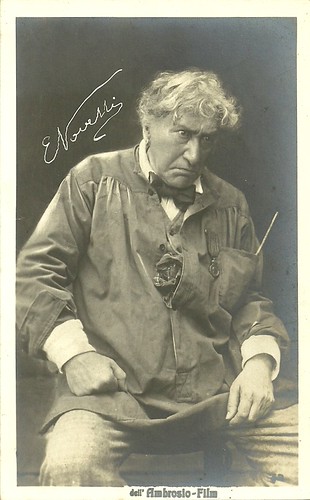
Ermete Novelli. Italian postcard by La Rotofotografica, no. 52. Photo: Ambrosio-Film.
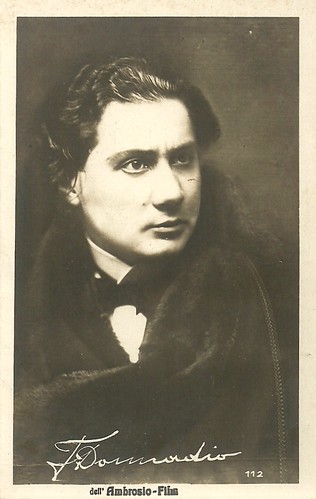
François-Paul Donadio. Italian postcard by La Rotografica, no. 112. Photo: Ambrosio Film.
The Ambrosio film company was founded in 1906 in Turin by Arturo Ambrosio and Alfredo Gandolfi, first as ‘Società Ambrosio & C.’, in 1907 turned into the public corporation ‘Società Anonima Ambrosio, Torino’.
From 1908, when it opened its new studio complex, until 1912 it flooded the world with its shorts and, from 1911 on, with its feature-length films, starting with L’ultimo dei Frontignac/The Last of the Frontignacs (Mario Caserini, 1911) with Alberto Capozzi.
In 1912 and 1913 Ambrosio managed to release around 200 films per year and shared with the Roman company Cines the primate of the Italian cinema on the international market. Ambrosio established worldwide its reputation and that of Italian cinema with the historical drama’s Gli ultimi giorni di Pompei/The Last Days of Pompei (Arturo Ambrosio, Luigi Maggi, 1908) and Nerone/Nero (Arturo Ambrosio, Luigi Maggi, 1909), both with Luigi Maggi and Lydia Roberti
Ambrosio’s historical films, released from 1909 on as ‘serie d’oro’ (Golden Series), were the firm’s business card. Among them were films as Spergiura!/Swear! (Arturo Ambrosio, Luigi Maggi, 1909, the first in the ‘serie d’oro’), Il granatiere Roland/Grenadier Roland (Luigi Maggi, 1911) and in 1913 the second version of Gli ultimi giorni di Pompei (Mario Caserini, Eleuterio Rodolfi, 1913), released in competition with that of Pasquali.
The historical films won Ambrosio much prestige. In 1911 the company received the prize for the best artistic film and best documentary at the International Exposition in Turin with the Risorgimento drama Nozze d’oro/The Golden Wedding (Arturo Ambrosio, Luigi Maggi, 1911), featuring the leading Ambrosio actors Alberto Capozzi and Mary Cléo Tarlarini, and the documentary La vita delle farfalle/Life of the Butterflies (Roberto Omegna, 1911), based on a text by Guido Gozzano.
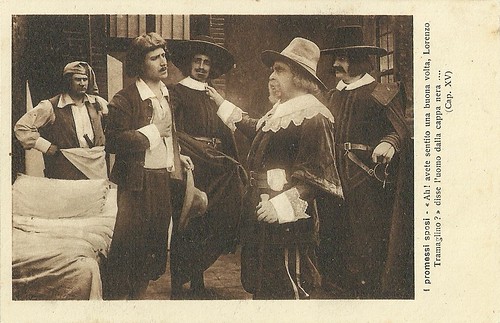
Italian postcard. Photo: Ambrosio. Publicity still for I promessi sposi (Eleuterio Rodolfi, 1913), adapted from Alessandro Manzoni's classic novel, and starring Mario Voller-Buzzi as Renzo and Gigetta Morano as Lucia. Here Renzo is about to be arrested on false accusation. Caption: Ah! Have you understood at last, Lorenzo Tramaglino?, the man with the black cape said. (Ch. XV).
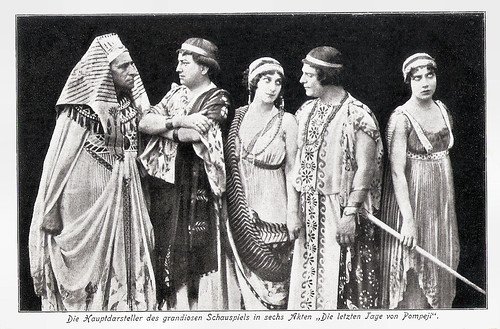
German postcard by Rodera-Lichtspiele, Dresden, 1913. Photo: Publicity still for Gli ultimi giorni di Pompei/The Last Days of Pompeii (Eleuterio Rodolfi, 1913). From left to right: Antonio Grisanti as Arbaces, the Egyptian High Priest of Isis; Cesare Gani Carini as Apecides; Eugenia Tettoni Fior as Jone; Ubaldo Stefani as Glaucus, Jone's lover; and Fernanda Negri Pouget as the blind slave Nidia. The film was produced by Società Anonima Ambrosio.

Italian postcard. Photo: Ambrosio Film. Publicity still for La Gorgona (Mario Caserini, 1915), scripted by Arrigo Frusta and starring a young Annibale Ninchi and French stage and screen actress Madeleine Céliat. The film was based on a play by Sem Benelli. The film was released in Rome on 9 March 1915.
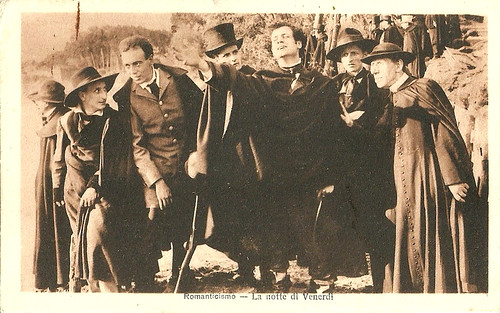
Italian postcard by IPA CT, no. 748. Photo: Film della Società Anonima Ambrosio, Torino. Publicity still for Romanticismo (Carlo Campogalliani, Arrigo Frusta, 1915) with Tullio Carminati. Caption: Friday Night. Romanticismo was based on a famous play by Gerolamo Rovetta, and was the film debut of diva Helena Makowska.
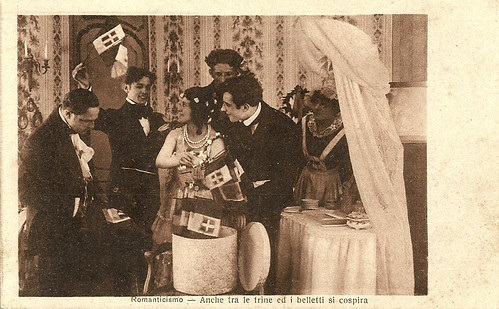
Italian postcard by IPA CT, no. 749. Photo: Film della Società Anonima Ambrosio, Torino. Publicity still for Romanticismo (1915) with Domenico Serra. Caption: There is also conspiration among the flags and the garments.
Considering other genres, Ambrosio profiled itself mainly through comedy such as the farces with the tall and anarchic Marcel Fabre alias Robinet and the corpulent but swift Ernesto Vaser alias Fricot. It also became well known for its boulevard-like comedies with Morano, Rodolfi en De Riso.
The company was famous for its actualities and travel films from all over Europe, sometimes including remarkable split-screen effects such as in Tripoli (Pietro Marelli, 1912), and its scientific films such as La nevropatologia/The Neuropathology (Camillo Negro, Roberto Omegna, 1908) on hysteria.
Ambrosio’s distribution reached as far as Russia. In 1909-1910 Ambrosio cameraman Giovanni Vitrotti shot films here and contributed to the start of the Russian film production.
In 1912 Ambrosio hired lion tamer Alfred Schneider and his lions for a series of sensational drama’s such as La nave dei leoni/The Ship With the Lions (Luigi Maggi, 1912), starring Mario Bonnard. Ambrosio never really was a production company of diva films, notwithstanding the sole production with stage star Eleonora Duse: Cenere/Ashes (Febo Mari, 1916).
After 1911 Ambrosio’s international market share started to drop in favour of that of Cines. The most serious problems however started with the outbreak of the First World War and Italy’s joining the Allied forces. The government requisitioned the studio complex for the construction of airplane propellers and production dropped to 9 films in 1917.
After the war Ambrosio tried to revive itself through expensive productions as La Nave/The Ship (Gabriellino D'Annunzio, Mario Roncoroni, 1921) with dancer Ida Rubinstein, and Teodora/Theodora (Leopoldo Carlucci, 1922), but they were economic failures.
Arturo Ambrosio left the company, the production stopped in 1923 and, one year after, the company was dissolved. In the two decennia of its productivity, Ambrosio released 1400 films, of which a little more than 1/10 remains today, mainly in the film archives of Turin, Amsterdam, London, Gemona, Bologna and Rome.
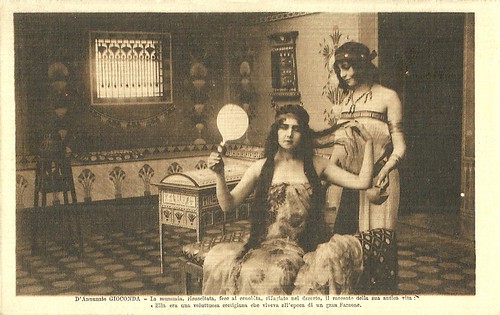
Italian postcard by IPA CT, no. 3873. Photo: Film della Società Ambrosio, Torino. Publicity still for the lost film La Gioconda (Eleuterio Rodolfi, 1916, released 1917), based on Gabriele D'Annunzio's play and with Helena Makowska as the Egyptian courtesan. Caption: The resurrected mummy told the monk, refugee in the desert, the story of her ancient life: She had been a voluptuous courtesan who lived in the times of the great Pharaon.'
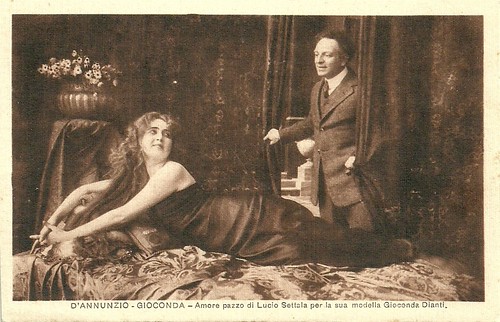
Italian postcard by IPA CT, no. 3876. Film della Soc. Ambrosio, Torino. V. Uff. Rev. St., Terni. Publicity still of Umberto Mozzato as Lucio Settala and Helena Makowska as Gioconda Dianti in La Gioconda (Eleuterio Rodolfi, 1916). Caption: Lucio Settala is madly in love with his model Gioconda Dianti.

Italian postcard by IPA CT Duplex. Photo: Film Società Anonima Ambrosio, Torino, no. 4043. Publicity still of Diana Karenne in Il romanzo di Maud aka Demi-vierges (1917), based on Marcel Prévost's novel Demi-vierges, and directed by Diana Karenne herself. The film stars Diana Karenne as Maud, while Alberto Capozzi plays Maxime and Francesco Cacace Julien.
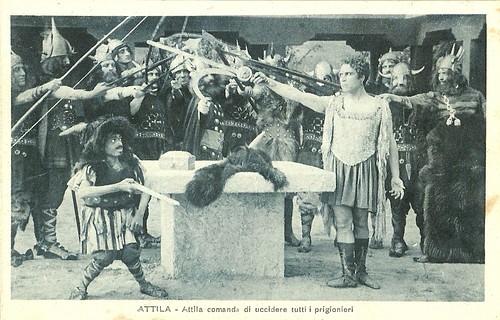
Italian postcard by IPA CT Duplex. Photo: Film Società Anonima Ambrosio, Torino. Publicity still of Febo Mari in the title role in Attila (Febo Mari, 1918). Caption: Attila orders to kill all prisoners.
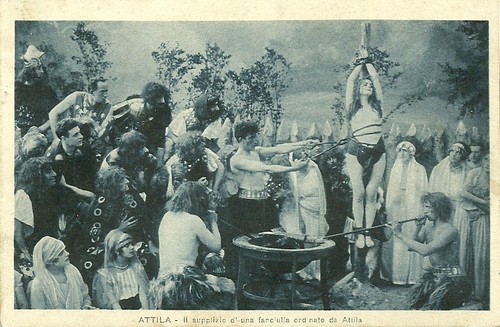
Italian postcard by IPA CT Duplex. Photo: Film Società Anonima Ambrosio, Torino. Publicity still of Febo Mari in the title role in Attila (Febo Mari, 1918). Caption: The torture of a girl by orders of Attila.
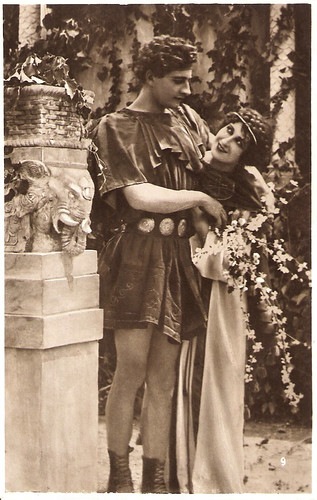
Italian postcard by Unione Cinematografica Italiana, no. 9. Photo: Ambrosio Film. Publicity still for Teodora (Leopoldo Carlucci, 1921). Caption: When Teodora (Rita Jolivet) meets the Greek Andrea (Ferruccio Biancini) she becomes his lover, pretending she is a widow with the name of Mirta.
Sources: Paolo Bertetto and Gianni Rondolino (Cabiria e il suo tempo - Italian), Ivo Blom (Encyclopedia of Early Cinema) and IMDb.

Febo Mari. Italian postcard by La Rotofotografica, no. 1. Photo: Ambrosio-Film.

Tullio Carminati. Italian postcard by La Rotofotografica, no. 27. Photo: Ambrosio Film. Tullio Carminati's outfit and hairdo reminds of these in the film Romanticismo (Carlo Campogalliani, Arrigo Frusta, 1915).

Diana Karenne. Dutch postcard for the Dutch Cinema Palace, Steenstraat, Arnhem, sent 17 February 1919, from Apeldoorn, to a girlfriend in Ghent, Belgium. Photo: Ambrosio, Torino. The postcard could have been to promote Sofia di Kravonia, shown at this cinema in September 1918.

Ermete Novelli. Italian postcard by La Rotofotografica, no. 52. Photo: Ambrosio-Film.

François-Paul Donadio. Italian postcard by La Rotografica, no. 112. Photo: Ambrosio Film.
Flooding the world with shorts and features
The Ambrosio film company was founded in 1906 in Turin by Arturo Ambrosio and Alfredo Gandolfi, first as ‘Società Ambrosio & C.’, in 1907 turned into the public corporation ‘Società Anonima Ambrosio, Torino’.
From 1908, when it opened its new studio complex, until 1912 it flooded the world with its shorts and, from 1911 on, with its feature-length films, starting with L’ultimo dei Frontignac/The Last of the Frontignacs (Mario Caserini, 1911) with Alberto Capozzi.
In 1912 and 1913 Ambrosio managed to release around 200 films per year and shared with the Roman company Cines the primate of the Italian cinema on the international market. Ambrosio established worldwide its reputation and that of Italian cinema with the historical drama’s Gli ultimi giorni di Pompei/The Last Days of Pompei (Arturo Ambrosio, Luigi Maggi, 1908) and Nerone/Nero (Arturo Ambrosio, Luigi Maggi, 1909), both with Luigi Maggi and Lydia Roberti
Ambrosio’s historical films, released from 1909 on as ‘serie d’oro’ (Golden Series), were the firm’s business card. Among them were films as Spergiura!/Swear! (Arturo Ambrosio, Luigi Maggi, 1909, the first in the ‘serie d’oro’), Il granatiere Roland/Grenadier Roland (Luigi Maggi, 1911) and in 1913 the second version of Gli ultimi giorni di Pompei (Mario Caserini, Eleuterio Rodolfi, 1913), released in competition with that of Pasquali.
The historical films won Ambrosio much prestige. In 1911 the company received the prize for the best artistic film and best documentary at the International Exposition in Turin with the Risorgimento drama Nozze d’oro/The Golden Wedding (Arturo Ambrosio, Luigi Maggi, 1911), featuring the leading Ambrosio actors Alberto Capozzi and Mary Cléo Tarlarini, and the documentary La vita delle farfalle/Life of the Butterflies (Roberto Omegna, 1911), based on a text by Guido Gozzano.

Italian postcard. Photo: Ambrosio. Publicity still for I promessi sposi (Eleuterio Rodolfi, 1913), adapted from Alessandro Manzoni's classic novel, and starring Mario Voller-Buzzi as Renzo and Gigetta Morano as Lucia. Here Renzo is about to be arrested on false accusation. Caption: Ah! Have you understood at last, Lorenzo Tramaglino?, the man with the black cape said. (Ch. XV).

German postcard by Rodera-Lichtspiele, Dresden, 1913. Photo: Publicity still for Gli ultimi giorni di Pompei/The Last Days of Pompeii (Eleuterio Rodolfi, 1913). From left to right: Antonio Grisanti as Arbaces, the Egyptian High Priest of Isis; Cesare Gani Carini as Apecides; Eugenia Tettoni Fior as Jone; Ubaldo Stefani as Glaucus, Jone's lover; and Fernanda Negri Pouget as the blind slave Nidia. The film was produced by Società Anonima Ambrosio.

Italian postcard. Photo: Ambrosio Film. Publicity still for La Gorgona (Mario Caserini, 1915), scripted by Arrigo Frusta and starring a young Annibale Ninchi and French stage and screen actress Madeleine Céliat. The film was based on a play by Sem Benelli. The film was released in Rome on 9 March 1915.

Italian postcard by IPA CT, no. 748. Photo: Film della Società Anonima Ambrosio, Torino. Publicity still for Romanticismo (Carlo Campogalliani, Arrigo Frusta, 1915) with Tullio Carminati. Caption: Friday Night. Romanticismo was based on a famous play by Gerolamo Rovetta, and was the film debut of diva Helena Makowska.

Italian postcard by IPA CT, no. 749. Photo: Film della Società Anonima Ambrosio, Torino. Publicity still for Romanticismo (1915) with Domenico Serra. Caption: There is also conspiration among the flags and the garments.
Hiring a lion tamer for sensational dramas
Considering other genres, Ambrosio profiled itself mainly through comedy such as the farces with the tall and anarchic Marcel Fabre alias Robinet and the corpulent but swift Ernesto Vaser alias Fricot. It also became well known for its boulevard-like comedies with Morano, Rodolfi en De Riso.
The company was famous for its actualities and travel films from all over Europe, sometimes including remarkable split-screen effects such as in Tripoli (Pietro Marelli, 1912), and its scientific films such as La nevropatologia/The Neuropathology (Camillo Negro, Roberto Omegna, 1908) on hysteria.
Ambrosio’s distribution reached as far as Russia. In 1909-1910 Ambrosio cameraman Giovanni Vitrotti shot films here and contributed to the start of the Russian film production.
In 1912 Ambrosio hired lion tamer Alfred Schneider and his lions for a series of sensational drama’s such as La nave dei leoni/The Ship With the Lions (Luigi Maggi, 1912), starring Mario Bonnard. Ambrosio never really was a production company of diva films, notwithstanding the sole production with stage star Eleonora Duse: Cenere/Ashes (Febo Mari, 1916).
After 1911 Ambrosio’s international market share started to drop in favour of that of Cines. The most serious problems however started with the outbreak of the First World War and Italy’s joining the Allied forces. The government requisitioned the studio complex for the construction of airplane propellers and production dropped to 9 films in 1917.
After the war Ambrosio tried to revive itself through expensive productions as La Nave/The Ship (Gabriellino D'Annunzio, Mario Roncoroni, 1921) with dancer Ida Rubinstein, and Teodora/Theodora (Leopoldo Carlucci, 1922), but they were economic failures.
Arturo Ambrosio left the company, the production stopped in 1923 and, one year after, the company was dissolved. In the two decennia of its productivity, Ambrosio released 1400 films, of which a little more than 1/10 remains today, mainly in the film archives of Turin, Amsterdam, London, Gemona, Bologna and Rome.

Italian postcard by IPA CT, no. 3873. Photo: Film della Società Ambrosio, Torino. Publicity still for the lost film La Gioconda (Eleuterio Rodolfi, 1916, released 1917), based on Gabriele D'Annunzio's play and with Helena Makowska as the Egyptian courtesan. Caption: The resurrected mummy told the monk, refugee in the desert, the story of her ancient life: She had been a voluptuous courtesan who lived in the times of the great Pharaon.'

Italian postcard by IPA CT, no. 3876. Film della Soc. Ambrosio, Torino. V. Uff. Rev. St., Terni. Publicity still of Umberto Mozzato as Lucio Settala and Helena Makowska as Gioconda Dianti in La Gioconda (Eleuterio Rodolfi, 1916). Caption: Lucio Settala is madly in love with his model Gioconda Dianti.

Italian postcard by IPA CT Duplex. Photo: Film Società Anonima Ambrosio, Torino, no. 4043. Publicity still of Diana Karenne in Il romanzo di Maud aka Demi-vierges (1917), based on Marcel Prévost's novel Demi-vierges, and directed by Diana Karenne herself. The film stars Diana Karenne as Maud, while Alberto Capozzi plays Maxime and Francesco Cacace Julien.

Italian postcard by IPA CT Duplex. Photo: Film Società Anonima Ambrosio, Torino. Publicity still of Febo Mari in the title role in Attila (Febo Mari, 1918). Caption: Attila orders to kill all prisoners.

Italian postcard by IPA CT Duplex. Photo: Film Società Anonima Ambrosio, Torino. Publicity still of Febo Mari in the title role in Attila (Febo Mari, 1918). Caption: The torture of a girl by orders of Attila.

Italian postcard by Unione Cinematografica Italiana, no. 9. Photo: Ambrosio Film. Publicity still for Teodora (Leopoldo Carlucci, 1921). Caption: When Teodora (Rita Jolivet) meets the Greek Andrea (Ferruccio Biancini) she becomes his lover, pretending she is a widow with the name of Mirta.
Sources: Paolo Bertetto and Gianni Rondolino (Cabiria e il suo tempo - Italian), Ivo Blom (Encyclopedia of Early Cinema) and IMDb.
No comments:
Post a Comment